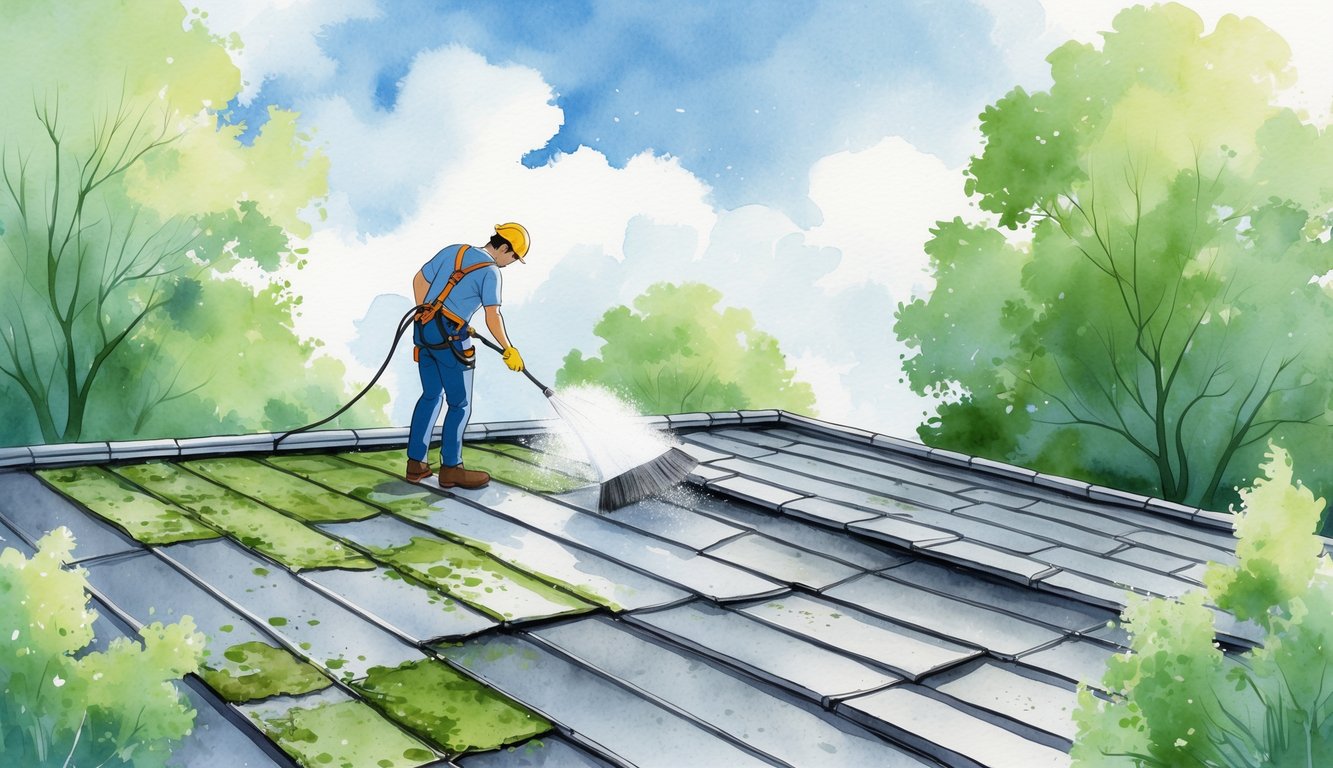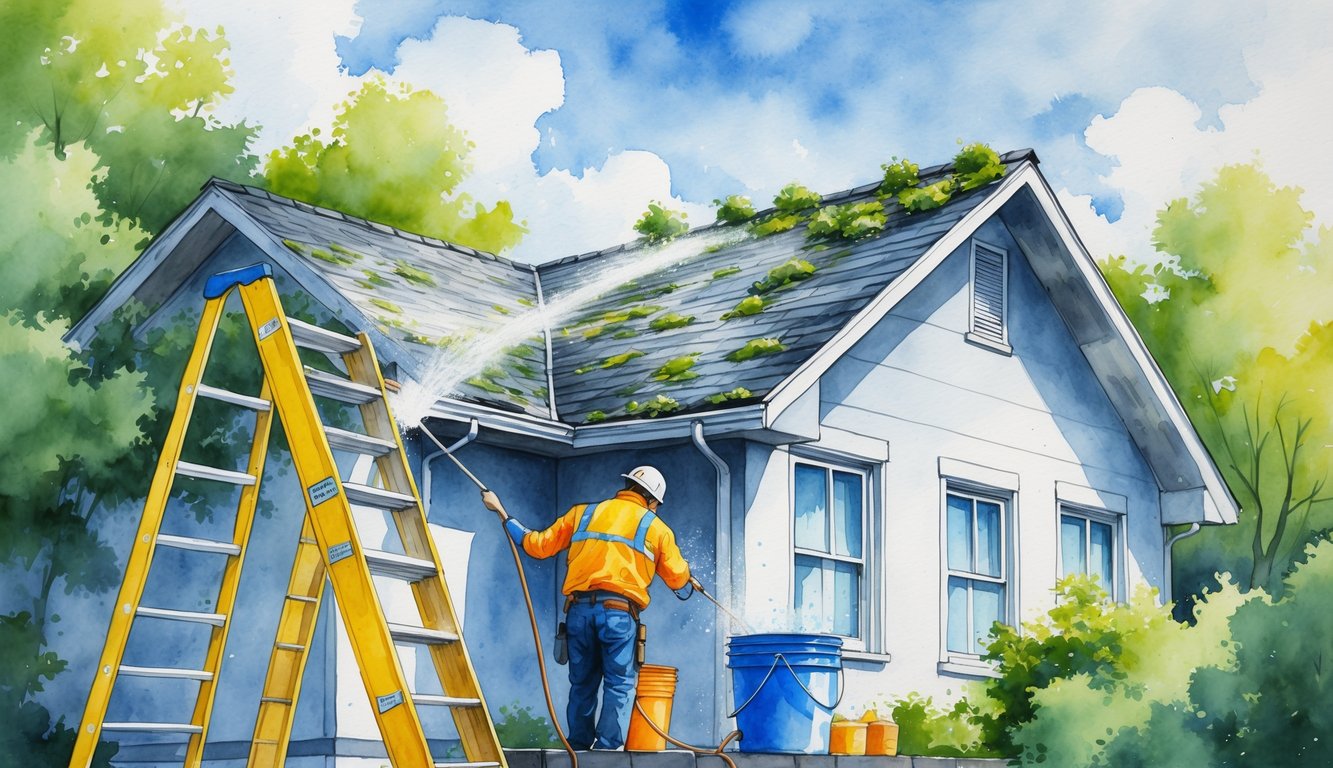
Step-by-Step Roof Cleaning Process

Standing there in boots sliding around on what feels like algae-slathered linoleum, I can tell you—roof cleaning is about stubborn gunk and bird droppings, not tidy checklists. The pros I know (especially my old boss, who can quote insurance stats like baseball scores) all say the same thing: skip a prep step, regret it for months. Rush the rinse, enjoy shingle granules in your gutters ‘til next season. Ask me how I know.
Preparing the Roof Surface
Nobody warns you about spider webs or petrified acorns, but that’s what you’ll find. I always start by hand—leaf blowers just launch debris into the neighbor’s pool. Gutters full of syrupy leaves? Slip hazard. Broken shingles, loose flashing, split seams—ignore those and you’ll be patching leaks in no time.
My “checklist” is all in my head: stomp every foot, look for buckles, poke at corners. If something crumbles, it’s a repair, not a shortcut. Thick gloves, always—my last tetanus shot was ages ago. Want numbers? Some environmental journal claims 40% of roof leaks start with missed prep or ignored debris. That’s why pros swear by surface prep.
Applying Cleaning Solution Properly
Dumping bleach like I’m watering tomatoes? Nope. For asphalt, I stick to a low-pressure sodium hypochlorite mix—SoftWash keeps the granules where they belong and runoff low. My old insurance guy swears it cuts claims in half. Always dilute, read the specs, work top-down (unless you love streaks).
Rookie mistake: soak the whole roof at once. I do small sections—if it dries, you’re scrubbing twice and wasting gallons. Non-slip shoes, cat litter for spills (because, trust me, they’ll happen). Monarch Roofing told me heavy concentrations can void warranties, so I’m always double-checking chemistry and roof type (see their guide). Never mix products. Seriously, don’t.
Rinsing Thoroughly and Finishing Up
Rinsing? Total pain. Everyone underestimates runoff—gravity never takes a break. I start at the ridge, use a garden hose (pressure washer is for demolition, not cleaning). Sometimes the wind turns and I end up soaked, but whatever.
I watch how water beads—uneven means cleaner’s still lurking, ready to eat through the coating. Gutters? Always check again after rinsing. Anything left turns into a clog—don’t ask about the summer I spent elbow-deep in pine needles. Veteran cleaners agree: finish with a walkaround, check every flashing. The family thinks I’m just admiring my work, but really, I’m hunting for missed spots. It never looks perfect. Who cares? Perfection isn’t waterproof.
Addressing Common Roof Contaminants

Nothing goes as planned—moss comes back after every rain, lichen clings like it’s glued on, and mold? Black streaks just wander wherever they want. The more I prep, the worse it looks. Why is that?
Removing Moss, Algae, and Lichen
Last April, I wasted an hour on my neighbor’s roof—she tried her kitchen mop, swore it’d work. Nope. Moss and algae need real roof cleaner, not leftover bathroom spray. Sodium hypochlorite (bleach) diluted about 75/25 with water (see these roofing folks)—spray top-down, let it sit.
Pressure washing asphalt? Don’t. All you do is blow granules into the gutters. I always check for loose tiles, soft wash, or go at it with a plastic brush. My cousin says timing matters—never do it below 40°F or just after rain, or you’re just moving slime around. Gloves will stink for days, just saying.
Eliminating Mold Growth and Black Roof Stains
Those black stains on my roof? They never just disappear. I swear they’re morphing into little grimacing faces every spring, like they’re mocking my housekeeping skills. Mold loves lurking in damp, shaded corners—especially if I’m too lazy to clear off the pine needles. Apparently, there are roof-specific cleaning products (not the random kitchen stuff I tried once), and the surfactants in those actually break up the spores and stains without completely trashing the shingles. At least, that’s what the roof cleaning best practices people say. Who knows.
Something nobody warns you about: if you just slap on cleaner and walk away, you’ll miss all the gunk hiding in the cracks. I use a long-handled, soft brush to stir things up, let it sit, then rinse—sometimes I forget, and the stains just come back. I try to get inspections done in early fall, right before the rain turns my roof into a mossy disaster (see climate-specific cleaning tips). Mold isn’t just ugly; it chews through the roof and can mess with indoor air. Why can’t it just grow in nice, straight, easy-to-clean lines? Wouldn’t that be considerate.
Roof Type Considerations and Expert Advice
Anyone else constantly forget which roof needs what? I do. Saw moss on my neighbor’s place, spent an hour lost in Google Image searches of fungus. Asphalt, metal, tile, slate—every so-called expert has their own “secret trick,” and half of them sound like ways to void a warranty.
Caring for Asphalt and Metal Roofs
Wiping algae off asphalt shingles? Not as straightforward as it sounds. The granules get everywhere, I end up itching, then remember I’m supposed to use a gentle roof cleaning solution and a soft-bristle brush. Never a broom. High-pressure washers? I tried once—bad idea. The granules came off like I was mowing the roof. Science apparently backs this up.
Metal roofs—everyone freaks out about corrosion. I mean, sure, but unless you’re on the coast, salt isn’t your main problem. It’s those fasteners. I keep finding rust on flashings I thought were fine. A wet rag and a little dish soap gets most of it, but if you forget to rinse, hello streaks. Supposedly, UV sealant helps with fading. I never remember, and honestly, nobody’s ever complimented my roof’s “vibrancy” anyway.
Eco-friendly cleaners? People talk a big game, but when I peek in garages, it’s always the cheapest bottle from the hardware store. Manufacturers warn against harsh chemicals. If you care about your warranty, you’re supposed to follow the label exactly. Who really does that?
Special Tips for Tile and Slate Roofs
Every time I’m up on a slate roof, I remember someone told me cracked tiles are fine—until your foot goes through. Tile roofs trap leaves and junk under the overlaps. Wire brush? Please, you’ll just chip the glaze. Leaf blower? Sure, if you want your neighbors to hate you. Plastic scraper if you have patience. (Spoiler: I don’t.) Copper or zinc strips at the ridge are supposed to stop moss, but only if you have the right slope and no trees. It’s always something.
Slate roofs? Gorgeous, but a nightmare. Slippery after rain. I use a ladder hook and stay low, because pressure washing is just asking for trouble (even experts say so). Diluted cleaner and rags, that’s my routine. Someone said always check for loose slates before stepping, but I forgot once and left a boot print on the attic ceiling. Oops.
Manufacturers talk about “routine inspections,” but nobody says what that means. My real advice? Tape your phone to a broomstick and take close-ups, so you don’t break your neck. Deep cleaning costs a fortune, and honestly, if you ever meet someone who dusts their slate roof for fun, brace yourself for a rant about rain acidity and lichen. I’ve been there.